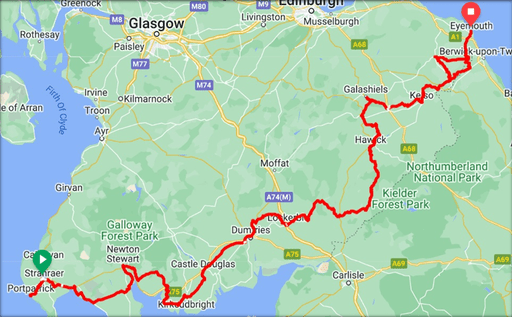Investing In Scotland's Coast: The Future Of Seagrass Planting

Table of Contents
The Ecological Importance of Seagrass in Scotland
Seagrass, often overlooked, plays a crucial role in the health and vitality of Scotland's marine ecosystem. These underwater meadows are far more than just pretty plants; they are biodiversity hotspots and essential components of a thriving coastal environment. Their importance is multifaceted, impacting everything from climate change mitigation to supporting local fisheries.
- Carbon sequestration: Seagrass beds are incredibly efficient at absorbing carbon dioxide (CO2) from the atmosphere, storing it in their sediments. This "blue carbon" sequestration is significantly more effective than terrestrial forests, making seagrass planting a powerful tool in the fight against climate change and a key part of Scotland's net-zero ambitions. This is crucial for mitigating the effects of global warming on Scotland’s delicate coastal ecosystems.
- Biodiversity: Seagrass meadows provide vital habitat and nursery grounds for a vast array of marine species. From commercially important fish like cod and plaice to invertebrates like shrimp and crabs, and even seahorses and other unique species, these underwater grasslands support a complex food web. Protecting seagrass directly protects the biodiversity that depends on it. Increased seagrass planting in Scotland directly contributes to biodiversity initiatives.
- Coastal protection: The dense root systems of seagrass act as natural buffers, reducing coastal erosion and mitigating the impact of storms and waves. This natural coastal defense is increasingly important in the face of rising sea levels and more frequent extreme weather events, safeguarding coastal communities and infrastructure. Seagrass planting for coastal protection is becoming increasingly vital.
- Water quality improvement: Seagrass plays a significant role in filtering pollutants and improving water clarity. By absorbing excess nutrients and trapping sediment, seagrass helps to create cleaner, healthier waters, benefiting both marine life and human users of Scotland's coastal areas. Improving water quality through seagrass planting is a key aspect of environmental sustainability initiatives.
- Fisheries support: Many commercially important fish species rely on seagrass beds for food and shelter during crucial life stages. Investing in seagrass restoration directly contributes to the health and productivity of Scotland's fisheries, supporting local economies and livelihoods. Sustainable fisheries management and seagrass planting go hand-in-hand.
Investing in Seagrass Restoration Projects in Scotland
There are various avenues for investing in seagrass restoration projects in Scotland, offering opportunities for both public and private entities to contribute to a healthier marine environment.
- Government funding and grants: The Scottish Government, along with organizations like NatureScot, offers various grants and funding programs specifically aimed at supporting marine conservation projects, including seagrass restoration. These funds can be used to support research, planting initiatives, and long-term monitoring.
- Private sector partnerships: Businesses can play a significant role through corporate social responsibility (CSR) initiatives and carbon offsetting schemes. Investing in seagrass planting provides a tangible way for companies to demonstrate their commitment to environmental sustainability and reduce their carbon footprint. This also presents opportunities for innovative partnerships between businesses and conservation organizations.
- Community involvement: Local communities and volunteer groups are crucial in seagrass planting and monitoring efforts. Their local knowledge and dedication are invaluable in ensuring the long-term success of these projects. Community-led initiatives can create a strong sense of ownership and responsibility for the local environment.
- Return on investment (ROI): While the primary focus should be on the ecological benefits, investing in seagrass restoration also offers potential financial returns. This can include increased tourism revenue, enhanced fisheries yields, and the sale of carbon credits generated through blue carbon sequestration. A comprehensive cost-benefit analysis can demonstrate the long-term economic viability of such projects.
Challenges and Opportunities in Seagrass Planting
While the benefits of seagrass planting are clear, there are challenges involved in successful restoration.
- Suitable site identification: Selecting appropriate sites for planting is crucial. Factors such as water depth, sediment type, light availability, and water quality must be carefully considered to ensure the survival and growth of the seagrass.
- Monitoring and evaluation techniques: Regular monitoring and evaluation are essential to assess the success of planting projects and adapt strategies as needed. This may involve using advanced technologies for remote sensing and underwater surveys.
- Funding limitations and securing long-term financial support: Securing consistent, long-term funding is crucial for the success of seagrass restoration projects. This requires collaboration between government, private sector, and community stakeholders to establish sustainable funding mechanisms.
- Innovative technologies: New technologies are continually being developed to enhance seagrass planting efficiency and success, including drone technology for monitoring, biodegradable planting materials, and innovative seeding techniques.
The Future of Seagrass Planting and its Economic Impact
A healthy seagrass ecosystem brings significant long-term economic benefits to Scotland's coastal communities.
- Ecotourism: Thriving coastal ecosystems attract tourists, generating revenue for local businesses and creating jobs in the tourism sector. Seagrass meadows can become a key attraction for eco-tourism initiatives, highlighting the natural beauty and ecological importance of Scotland's coast.
- Fisheries enhancement: Improved fish stocks resulting from increased seagrass habitat can lead to a more productive and sustainable fishing industry, supporting local livelihoods and food security.
- Carbon credits: Seagrass restoration projects can generate revenue through the sale of carbon credits, creating a financial incentive for investment and conservation. This blue carbon market presents a significant opportunity for funding sustainable projects.
- Job creation: Seagrass restoration projects themselves create jobs in areas like ecological surveying, planting, monitoring, and related industries, contributing to economic growth in coastal communities. The creation of green jobs in this sector supports sustainable employment opportunities.
Conclusion
Investing in seagrass planting in Scotland is not just an environmental imperative but also a smart economic strategy. Seagrass restoration offers significant ecological benefits while simultaneously creating economic opportunities and boosting coastal resilience. From combating climate change to supporting thriving fisheries and boosting ecotourism, the benefits are numerous.
Join the movement to protect Scotland's precious coastal environment. Explore investment opportunities in seagrass planting projects and help secure a thriving future for Scotland's coast and its marine life. Learn more about how you can contribute to seagrass planting in Scotland today! Support seagrass planting initiatives and help restore this vital ecosystem.

Featured Posts
-
 Exclusive Gigi Hadid Discusses Bradley Cooper In Rare Interview
May 05, 2025
Exclusive Gigi Hadid Discusses Bradley Cooper In Rare Interview
May 05, 2025 -
 Corinthians X Internacional Veja Onde Assistir O Jogo Ao Vivo Horario E Escalacoes Confirmadas
May 05, 2025
Corinthians X Internacional Veja Onde Assistir O Jogo Ao Vivo Horario E Escalacoes Confirmadas
May 05, 2025 -
 Kentucky Derby 2025 Live Stream Find The Best Online Viewing Experience
May 05, 2025
Kentucky Derby 2025 Live Stream Find The Best Online Viewing Experience
May 05, 2025 -
 Max Verstappen And Kelly Piquet Celebrate The Arrival Of Daughter Lily
May 05, 2025
Max Verstappen And Kelly Piquet Celebrate The Arrival Of Daughter Lily
May 05, 2025 -
 Formula 1 Star Max Verstappen Becomes A Father Announces Babys Name
May 05, 2025
Formula 1 Star Max Verstappen Becomes A Father Announces Babys Name
May 05, 2025
Latest Posts
-
 Kentucky Derby 2025 Streaming Pricing And Availability Comparison
May 05, 2025
Kentucky Derby 2025 Streaming Pricing And Availability Comparison
May 05, 2025 -
 Max Verstappen Becomes A Father Horners Reaction
May 05, 2025
Max Verstappen Becomes A Father Horners Reaction
May 05, 2025 -
 How To Watch The Kentucky Derby 2025 Online A Comprehensive Guide To Streaming
May 05, 2025
How To Watch The Kentucky Derby 2025 Online A Comprehensive Guide To Streaming
May 05, 2025 -
 Tioga Downs 2025 What To Expect From The Upcoming Racing Season
May 05, 2025
Tioga Downs 2025 What To Expect From The Upcoming Racing Season
May 05, 2025 -
 Verstappens Fatherhood Christian Horners Jocular Comment
May 05, 2025
Verstappens Fatherhood Christian Horners Jocular Comment
May 05, 2025
